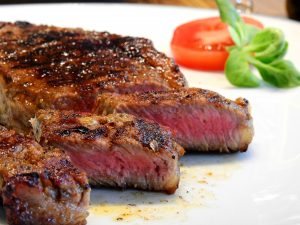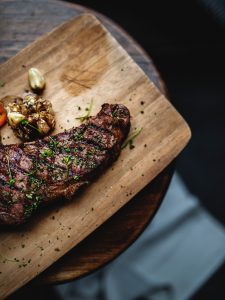 You’ve been lied to. Tricked! Fooled! Bamboozled!
You’ve been lied to. Tricked! Fooled! Bamboozled!
Ok, maybe just really misled. But no more!
We’ve been told by so many people, and a lot of advertisers, what makes good beef, that the old wisdom of raising cattle has been forgotten. And now, shunned.
Misconception #1
Younger beef is tender because it hasn’t had time to “toughen up”.
NOT TRUE!
Beef is tender for two reasons: the amount of marbling within the muscle and how much that muscle was used.
When beef is grain-fed, the age doesn’t matter because the grain adds the extra fat creating marbling.
When beef is completely grass-fed and grass-finished, it takes longer to create that marbling, but it does happen.
Some cuts will always be more tender than others. After all, some muscles get more of a workout than others. Filets are hardly worked and rump roasts help the animal move around–a lot of work. So of course one will be more tender than the other.
Just because one cuts is “tougher” doesn’t mean it isn’t good, you just have to know how to prepare it. I’ve been thin-slicing roasts and marinading them overnight for amazing tacos and stir-fry.
Misconception #2
Old cows are only good for ground beef. 
So, so, so UNTRUE!
I know this one first hand. Remember Queen, the cow we lost this past winter? We had her butchered on-farm and she produced the best beef we’ve ever eaten.
Every steak was almost too tender. The ground beef was so flavorful I hated adding seasoning.
Then I found this video that compares a young steer (28 months which is older than the usual 18 month-old steers found in the store) with older cows (8 and 15 years old) Spoiler alert: The oldest cow was the best! Click here to watch the video.
So why do sooooo many people think this? I think it’s just lost knowledge.
I hear so many of our older customers say our meat tastes like what they grew eating. The flavor, the texture, the color–it’s old school. That’s because our beef is raised like it used to be–on grass, always outside, room to roam, and butchered older.
Add to that a huge marketing campaign to convince everyone that younger beef is better, and it’s no wonder small farmers are convinced it’s not worth the gas to the butcher to process an old cow.
Misconception #3
Older beef has a strong flavor.
Yes! It’s called BEEF FLAVOR!!!!!
The older the beef gets, the more flavor it develops. Do you squish grapes, put it in a glass, and call it wine? No!
Beef develops, creates, becomes flavor.
So many of us have forgotten what REAL beef tastes like. You don’t have to dress it up and slather it in sauce–the flavor does the work. The only thing I put on our steaks or burgers is salt. If it’s quality beef, that’s all you need.
It’s not just age that affects flavor. The breed, feed, and time of year butchered have an effect as well.
Every breed has different growth rates and flavor profiles. When someone is new to grass-fed/finished beef, I tell them to shop around and find a breed they like.
You are what you eat, goes for cattle as well. Even in the same county, pastures are different, so the beef will taste different.
With grass-fed/finished beef, time of year the beef is butchered not only affects the flavor but the marbling. Two months after the spring grass flush is prime time for butchering. They’ve put on lots of good fat marbling from the lush grass. Two months into winter hay feeding, they may start to lose some of that marbling and flavor.
So what does all of this mean for you as a consumer?
Don’t believe the hype. Young “tender” beef (15-18 mths old) fattened and/or finished on grain was a marketing campaign to get cattle to the butcher quicker, not to get you quality beef.
Talk to your farmer about what breeds they raise, age of butcher, time of year they’re butchered, and what they eat.
Also, make sure to ask how they are finished and supplemented; 30+ days grain finish (even organic grain) negates the benefits of grass-fed beef. Grass-fed/finished beef contains up to five times as much omega-3, about twice as much Conjugated linoleic acid (CLA), and much less monounsaturated fat than grain-fed beef. Who wants to lose that!?

The best beef we have had was an “older” cow who was over 30 months old when we processed her. I just read your post to my husband, we may not ship our next older cow off, but have her processed and appreciate all shes done for us. Thank you for writing this.
You are so welcome! When I tell other producers about the age we butcher, they are skeptical. Once you taste the difference, it’s a whole new world! Let me know how it turns out.
What does “finished” mean. Is that a certain amount of time that a cow is fed certain things?
Dad
Yes. A lot of producers add grain to the diet for the last 30-180 days to add marbling quickly.
Just watched that video and I am amazed at how awesome that older steak looked!! But what can a farmer do? Didn’t they mention that because of mad cow a cow over 30 months has to have its spine removed? Is that why you had yours butchered on the farm? Forgive dumb questions. This is all so new to me. I’d like to try this taste comparison myself. Who wouldn’t want more beef flavor? I’m ready to order some older beef as long as it doesn’t have sugar added in the processing. 🙂
No, she was on-farm because she was injured. Her fat was that yellow as well. And delicious! All of our steaks are boneless because of the 30 month rule.
I said, “good grief” cause I can’t believe the stuff I’ve missed over the years, lol. I’m just surprised I’ve never heard any of those myths before. Thank you for setting the record straight like always!! {{hugs}}
Well good grief, I never heard of any of those things, but I only eat grass fed/grass finished now because I digest it much easier and it tastes yummy. IF older beef has a stronger flavor, then ‘bring it on’ LOL. I’m always learning fascinating things on your blog, Serena. Thank you. 🙂 Gonna go watch that video you linked to now.